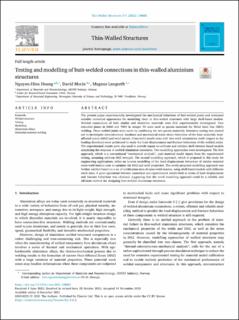| dc.contributor.author | Hoang, Nguyen-Hieu | |
| dc.contributor.author | Morin, David | |
| dc.contributor.author | Langseth, Magnus | |
| dc.date.accessioned | 2023-07-06T10:41:47Z | |
| dc.date.available | 2023-07-06T10:41:47Z | |
| dc.date.created | 2022-04-08T14:50:26Z | |
| dc.date.issued | 2022 | |
| dc.identifier.citation | Thin-walled structures. 2022, 171, 108681. | en_US |
| dc.identifier.issn | 0263-8231 | |
| dc.identifier.uri | https://hdl.handle.net/11250/3076542 | |
| dc.description.abstract | The present paper experimentally investigated the mechanical behaviour of butt-welded joints and evaluated suitable numerical approaches for modelling them in thin-walled structures with large shell-based models. Welded connections of both similar and dissimilar materials were first experimentally investigated. Two extruded plates in 6060 and 7003 in temper T6 were used as parent materials for Metal Inert Gas (MIG) welding. Three welded joints were made by combining the two parent materials. Extensive testing was carried out to investigate microstructure, hardness and mechanical stress–strain behaviour of the base materials, heat-affected zones (HAZ) and weld metals. Cross-weld tensile tests with two weld orientations (with respect to the loading direction) were performed to study the load–displacement and fracture behaviour of the welded joints. The experimental results were also used to provide inputs to calibrate and validate shell element-based models simulating the response of welded aluminium structures. Two modelling approaches were investigated. The first approach, which is a conventional “mechanical analysis”, used material model inputs from the experimental testing, assuming uniform HAZ strength. The second modelling approach, which is proposed in this study for engineering applications, relies on inverse modelling of the load–displacement behaviour of similar material cross-weld tension tests to optimize the HAZ and weld properties. The newly proposed modelling approach was further verified based on a set of verification tests of cross-weld tension, using shell-based models with different mesh sizes. A good agreement between numerical and experimental results both in terms of load–displacement and fracture behaviour was obtained, suggesting that the novel modelling approach could be a reliable and efficient method for designing butt-welded aluminium structures. | en_US |
| dc.language.iso | eng | en_US |
| dc.publisher | Elsevier | en_US |
| dc.rights | Navngivelse 4.0 Internasjonal | * |
| dc.rights.uri | http://creativecommons.org/licenses/by/4.0/deed.no | * |
| dc.title | Testing and modelling of butt-welded connections in thin-walled aluminium structures | en_US |
| dc.type | Peer reviewed | en_US |
| dc.type | Journal article | en_US |
| dc.description.version | publishedVersion | en_US |
| dc.rights.holder | © 2021 The Authors. Published by Elsevier Ltd. | en_US |
| dc.source.pagenumber | 15 | en_US |
| dc.source.volume | 171 | en_US |
| dc.source.journal | Thin-walled structures | en_US |
| dc.identifier.doi | 10.1016/j.tws.2021.108681 | |
| dc.identifier.cristin | 2016245 | |
| dc.source.articlenumber | 108681 | en_US |
| cristin.ispublished | true | |
| cristin.fulltext | original | |
| cristin.qualitycode | 1 | |

